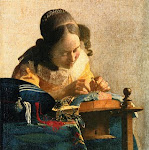
Thursday, October 27, 2011
Thursday, October 20, 2011
Anita Badami

Joke Klootwijk

Artist: Joke Klootwijk
Size: 14 x 14 cm
Medium& Support: Oil on a white acrylic panel
Artists Blog: http://www.jokeklootwijk.nl/
Artist website: http://www.aquarelleren.nl
Sunday, October 16, 2011
Renate Arends

Title
Artist
Medium & support : Watercolor, acryl (background), glue (background) and canvas
Size
Monday, October 10, 2011
Challenge 24 - Still Life With Cantaloupe

We had so much fun this time with the Old Door! Each of us learnt so much by simply observing how our other friends in PADT visualized the same subject in their painting. Each of us has his or her own style and it’s very refreshing to see same subject inspiring different images in different artists.
Reading a comment about what a viewer likes about our painting is very enlightening as well. The image which the viewer sees in our painting – is that what we had intended?
A big thank you to all who took the time to share their paintings and their feedback!
About the composition:
Prior to placing your brush on the canvas, take 15 min and carefully observe, observe and again OBSERVE the composition. What attracts your attention first? Let your eyes and imagination “travel” around and try to unfold the secret story hidden among its numerous reflections, worn out textures and shadows.
Your painting must convincingly tell your story - the one you are just about to visualize in your painting. Your story should strongly engage each viewer who must be able to hear it. If you don’t “see” it, you would not be able to paint it. The painting will be lifeless and speechless.
You want your painting to speak for you, to shout at each passerby, to tell your story and evoke emotions and feelings.
First, you need to get familiar with the shapes and the flow of the light, shadows, reflections, colors and textures in the composition. Identify all important elements, obvious and less obvious.
Make a confident plan about how to approach this composition. Once you get familiar with all elements that the composition has to offer, pick up your brush and emphasize it in your painting.
Important elements to consider
The light: A single source of light is entering the composition from the window at the top left, creating very pronounced shadows and “cast” shadows on the opposite side of the composition. The window is reflected in the form of highlights on the vase and cantaloupe seeds, following each shape and texture.
Shadows: Vase shadows are clearly defined on the opposite side of the light source. In addition to that, the vase casts a very subtle shadow on the background wall and cantaloupe. Each object has its shadow and casts another shadow on all surrounding surfaces and objects.
Reflections: The window is reflected in the vase with its bluish sky light all around the highlights. (The highlight is usually a reflection of the light source). Another very important reflection is the reflection of the cantaloupe on the vase. Emphasize it.
Texture: There is a variety of textures to portray. The vase has very intricate engraving with “valleys” painted in red and blue to emphasize the design. The cloth is an old fashioned - almost wooly textured - colorful tapestry that has seen many years of use and has a lot to tell and share. Worn out and partially torn, adding interest and supporting a bluish sky reflection and blue flower, it has been chosen as a complement to the orange cantaloupe.
Color harmony: Blue tapestry, sky light, flower, background. Green flower leaves, greenish reflections in the vase, yellow green on the cloth and at the bottom of the cantaloupe. Orange is a complement of blue and has its own place in the whole composition all around.
Please send a photo of your painting the latest by Sunday, Nov 13. The next painting reference will be posted on Nov 14th.
Nidhi Krishna









































































